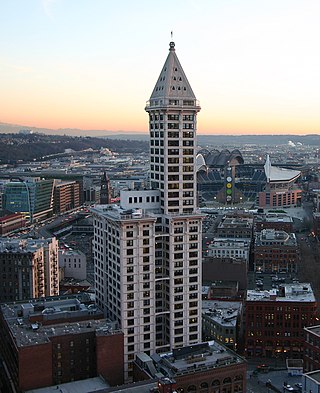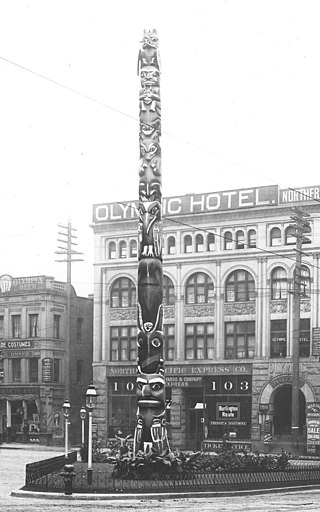
Smith Tower is a skyscraper in the Pioneer Square neighborhood of Seattle, Washington, United States. Completed in 1914, the 38-story, 462 ft (141 m) tower was among the tallest skyscrapers outside New York City at the time of its completion. It was the tallest building west of the Mississippi River until the completion of the Kansas City Power & Light Building in 1931. It remained the tallest building on the U.S. West Coast for nearly half a century, until the Space Needle overtook it in 1962.

Pioneer Square is a neighborhood in the southwest corner of Downtown Seattle, Washington, US. It was once the heart of the city: Seattle's founders settled there in 1852, following a brief six-month settlement at Alki Point on the far side of Elliott Bay. The early structures in the neighborhood were mostly wooden, and nearly all burned in the Great Seattle Fire of 1889. By the end of 1890, dozens of brick and stone buildings had been erected in their stead; to this day, the architectural character of the neighborhood derives from these late 19th century buildings, mostly examples of Richardsonian Romanesque.

State Route 99 (SR 99), also known as the Pacific Highway, is a state highway in the Seattle metropolitan area, part of the U.S. state of Washington. It runs 49 miles (79 km) from Fife to Everett, passing through the cities of Federal Way, SeaTac, Seattle, Shoreline, and Lynnwood. The route primarily follows arterial streets, including Aurora Avenue, and has several freeway segments, including the tolled SR 99 Tunnel in Downtown Seattle. SR 99 was officially named the William P. Stewart Memorial Highway by the state legislature in 2016, after a campaign to replace an unofficial moniker honoring Confederate president Jefferson Davis.

The Seattle Center Monorail is an elevated straddle-beam monorail line in Seattle, Washington, United States. The 0.9-mile (1.4 km) monorail runs along 5th Avenue between Seattle Center and Westlake Center in Downtown Seattle, making no intermediate stops. The monorail is a major tourist attraction but also operates as a regular public transit service with trains every ten minutes running for up to 16 hours per day. It was constructed in eight months at a cost of $4.2 million for the 1962 Century 21 Exposition, a world's fair hosted at Seattle Center. The monorail underwent major renovations in 1988 after the southern terminal was moved from its location over Pine Street to inside the Westlake Center shopping mall.

The Alaskan Way Viaduct was an elevated freeway in Seattle, Washington, United States, that carried a section of State Route 99. The double-decked freeway ran north–south along the city's waterfront for 2.2 miles (3.5 km), east of Alaskan Way and Elliott Bay, and traveled between the West Seattle Freeway in SoDo and the Battery Street Tunnel in Belltown.

The Downtown Seattle Transit Tunnel (DSTT), also referred to as the Metro Bus Tunnel, is a 1.3-mile-long (2.1 km) pair of public transit tunnels in Seattle, Washington, United States. The double-track tunnel and its four stations serve Link light rail trains on the 1 Line as it travels through Downtown Seattle. It runs west under Pine Street from 9th Avenue to 3rd Avenue, and south under 3rd Avenue to South Jackson Street. 1 Line trains continue north from the tunnel to Lynnwood City Center and south through the Rainier Valley past Seattle–Tacoma International Airport to Angle Lake station as part of Sound Transit's light rail network.

The Pioneer Building is a Richardsonian Romanesque stone, red brick, terra cotta, and cast iron building located on the northeast corner of First Avenue and James Street, in Seattle's Pioneer Square District. Completed in 1892, the Pioneer Building was designed by architect Elmer Fisher, who designed several of the historic district's new buildings following the Great Seattle Fire of 1889.

The South Lake Union Streetcar, officially the South Lake Union Line, is a streetcar route in Seattle, Washington, United States, forming part of the Seattle Streetcar system. It travels 1.3 miles (2.1 km) and connects Downtown Seattle to the South Lake Union neighborhood on Westlake Avenue, Terry Avenue, and Valley Street. The South Lake Union Streetcar was the first modern line to operate in Seattle, beginning service on December 12, 2007, two years after a separate heritage streetcar ceased operations.

International District/Chinatown station is a light rail station that is part of the Downtown Seattle Transit Tunnel in Seattle, Washington, United States. The station is located at the tunnel's south end, at 5th Avenue South and South Jackson Street in the Chinatown-International District neighborhood, and is served by the 1 Line of Sound Transit's Link light rail system. The station is located adjacent to Sound Transit headquarters at Union Station, as well as intermodal connections to Amtrak and Sounder commuter rail at King Street Station and the First Hill Streetcar.

Pioneer Square station is a light rail station that is part of the Downtown Seattle Transit Tunnel in Seattle, Washington, United States. The station is located under 3rd Avenue at James Street, between Symphony and International District/Chinatown stations. It is served by the 1 Line, part of Sound Transit's Link light rail system, and provides connections to local buses and Colman Dock, a major ferry terminal serving areas west of Seattle.

The State Route 99 tunnel, also known as the Alaskan Way Viaduct replacement tunnel, is a bored highway tunnel in the city of Seattle, Washington, United States. The 2-mile (3.2 km), double-decker tunnel carries a section of State Route 99 (SR 99) under Downtown Seattle from SoDo in the south to South Lake Union in the north.

The First Hill Streetcar, officially the First Hill Line, is a streetcar route in Seattle, Washington, United States, forming part of the modern Seattle Streetcar system. It travels 2.5 miles (4.0 km) between several neighborhoods in central Seattle, including the International District, First Hill, and Capitol Hill. The line has ten stops and runs primarily in mixed traffic on South Jackson Street and Broadway.

The Holyoke Building is a historic building located in downtown Seattle, Washington. It is a substantial five story brick structure with stone trimmings. Construction began at the corner of First Avenue and Spring Streets just before the Great Seattle fire of 1889. Completed in early 1890, it was among the first permanent buildings completed and ready for occupancy in downtown Seattle following the fire. Today the Holyoke Building is one of the very few such buildings still standing in Seattle outside of the Pioneer Square district and is a historic remnant of the northward expansion of Seattle's business district between the time of the great fire and the Yukon Gold Rush in 1897.

The Monte Cristo Hotel is a historic building located in Everett, Washington. It is a major feature of the city's downtown core. It ceased functioning as a hotel in 1972. It was listed on the National Register of Historic Places on June 3, 1976. In 1994 it was restored and redeveloped into low income housing.

The Amazon Spheres are three spherical conservatories comprising part of the Amazon headquarters campus in Seattle, Washington, United States. Designed by NBBJ and landscape firm Site Workshop, its three glass domes are covered in pentagonal hexecontahedron panels and serve as an employee lounge and workspace. The spheres, which range from three to four stories tall, house 40,000 plants, as well as meeting space and retail stores. They are located adjoining the Day 1 building on Lenora Street. The complex opened to Amazon employees and limited public access on January 30, 2018. The spheres are reserved mainly for Amazon employees, but are open to the public through weekly headquarters tours and an exhibit on the ground floor.

Julian Franklin Everett was an American architect known for the buildings he designed in Seattle, Washington. His work includes a synagogue for the Temple de Hirsch congregation (1908) and the Pioneer Square Comfort Station and Pergola in Seattle (1909), now a historic landmark. Some of his works, including the temple and a building for Pathé Exchange, were later demolished, while others are listed on the National Register of Historic Places (NRHP).

The Statue of Liberty, or Lady Liberty, is a replica of the Statue of Liberty installed at Seattle's Alki Beach Park, in the U.S. state of Washington. It was installed in 1952 by the Boy Scouts of America and underwent a significant restoration in 2007 after repeated vandalism had damaged the sculpture.

1st Avenue is a major street in Seattle, Washington, United States. It traverses Downtown Seattle, including Pioneer Square and Belltown, as well as the adjacent neighborhoods of SoDo and Lower Queen Anne. Numerous landmarks including parks, museums, and historic buildings are located along the street, including Pike Place Market. The Great Seattle Fire of 1889 destroyed much of it and it had to be rebuilt. Parades have taken place on it before and after the fire.

The Pioneer Square totem pole, also referred to as the Seattle totem pole and historically as the Chief-of-All-Women pole, is a Tlingit totem pole located in Pioneer Square in downtown Seattle, Washington.

The Mutual Life Building, originally known as the Yesler Building, is an historic office building located in Seattle's Pioneer Square neighborhood that anchors the West side of the square. The building sits on one of the most historic sites in the city; the original location of Henry Yesler's cookhouse that served his sawmill in the early 1850s and was one of Seattle's first community gathering spaces. It was also the site of the first sermon delivered and first lawsuit tried in King County. By the late 1880s Yesler had replaced the old shanties with several substantial brick buildings including the grand Yesler-Leary Building, which would all be destroyed by the Great Seattle Fire in 1889. The realignment of First Avenue to reconcile Seattle's clashing street grids immediately after the fire would split Yesler's corner into two pieces; the severed eastern corner would become part of Pioneer Square park, and on the western lot Yesler would begin construction of his eponymous block in 1890 to house the First National Bank, which had previously been located in the Yesler-Leary Building. Portland brewer Louis Feurer began construction of a conjoined building to the west of Yesler's at the same time. Progress of both would be stunted and the original plans of architect Elmer H. Fisher were dropped by the time construction resumed in 1892. It would take 4 phases and 4 different architects before the building reached its final form in 1905. The Mutual Life Insurance Company of New York only owned the building from 1896 to 1909, but it would retain their name even after the company moved out in 1916.





















